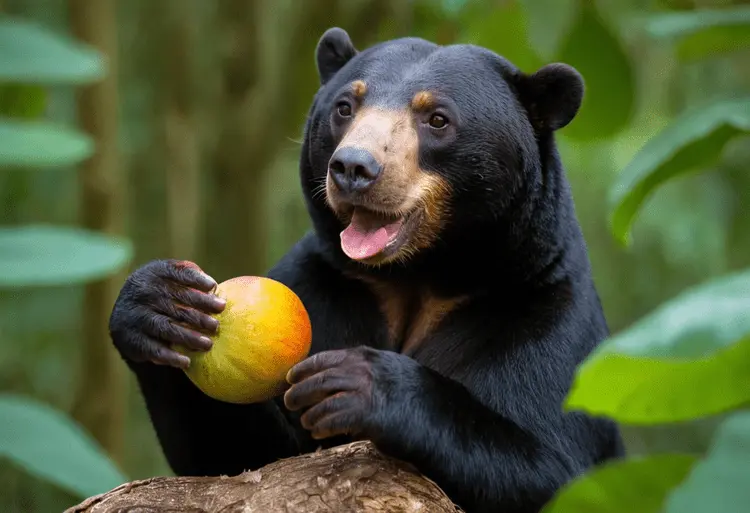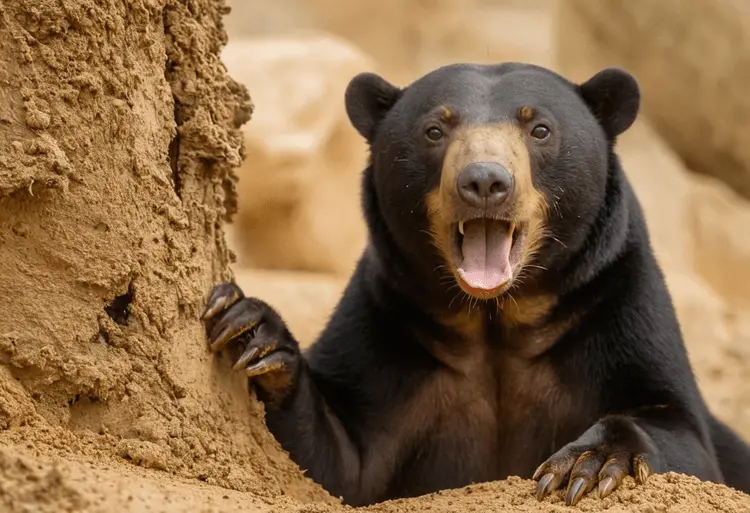Have you ever wondered about the fascinating sun bear diet? Unlike their massive grizzly cousins, these small bears have a surprisingly diverse menu.
Sure, they love honey, but what do sun bears eat besides raiding beehives? How do they find all those insects, and what fruits make up their rainforest feast? Understanding their unique sun bear feeding habits is crucial to appreciating their role in the ecosystem.
Fear not, animal lover! In this post, we’ll delve into everything you need to know about the sun bear diet. Discover their favorite sun bear foods, their clever foraging techniques, and why their sun bear nutrition matters for the future of rainforests.
Sun Bear Diet: The Short Version
- Eat fruits, insects, honey
- Sometimes eat small animals
- Adapt diet based on season
- Help spread seeds
- Control insect populations
Table of contents
Introduction

Have you ever wondered how the world’s smallest bear survives in the dense rainforests of Southeast Asia? The answer lies in the fascinating sun bear diet! Unlike their meat-loving cousins, sun bears have a surprisingly diverse menu.
Are you ready to dive into the sun bear’s world of culinary wonders? Think sweet, juicy figs, swarms of tasty termites, and of course, the golden nectar they crave – honey! These bears are true rainforest gourmands.
But how do they find all these delicious treats? That’s where things get really interesting! Sun bears have powerful claws to rip into logs and a super-long tongue made for slurping up insects.
Plus, check out their incredible sense of smell – it’s like they have a built-in food detector!
And get this: sun bears play a vital role in the rainforest. Think of them as nature’s gardeners and pest control experts. Every berry they munch on and every termite mound they demolish helps the rainforest thrive.
The sun bear’s love for honey might make you think twice about your own sweet tooth. Ready to find out which delicious foods are surprisingly good for lowering cholesterol?
The Sun Bear’s Eclectic Palate
Ever wondered what the world’s smallest bear eats? You might be surprised! Sun bears are true omnivores, meaning they feast on a fascinating mix of foods. This makes their diet incredibly diverse and adaptable.
Let’s explore what’s on the menu for these rainforest dwellers!
Omnivorous Opportunists
So, what does it mean to be an omnivore, exactly? It signifies that sun bears enjoy both plants and animals. This gives them plenty of options when it comes to finding a satisfying meal in their tropical forest home.
The Staples of the Sun Bear Diet
- Fruits: Sun bears have a real sweet tooth! Figs, berries, and other juicy fruits rank high on their favorites list. Think of them as the rainforest’s fruit snackers!
- Insects: Termites, beetles, ants – no creepy crawly is safe! Sun bears are insect-eating experts with powerful tools to access these tasty morsels. If you’re interested in learning about how they do this, check out this resource on rainforest insect biodiversity [External Link #2: Insect benefits in ecosystems].
- Honey: A sun bear’s love of honey runs deep. You might even call them professional honey hunters!
- Other Plant Matter: Sun bears munch on shoots, seeds, and other plant bits for extra nutrients and fiber.
Occasional Delicacies
Think their diet is exciting already? Sun bears occasionally expand their menu even further!
- Small Vertebrates: Birds, lizards, or rodents might become a rare but protein-rich snack.
- Eggs: A tasty and nutritious treat if they stumble across a nest.
Let me know if you’ve ever seen a sun bear snacking! Curious to hear your stories. Tag us on social media for a chance to be featured!
The Tools of the Trade – How Sun Bears Obtain Their Food
Powerful Claws and Teeth
Imagine nails so strong they can rip open tree trunks! That’s what sun bears have. These impressive claws are their primary “can openers,” tearing into rotten logs to reveal a feast of insects or breaking into beehives for sweet honey.
Their powerful teeth help too, crushing tough termite mounds for the tasty snacks inside.
A Tongue Designed for the Job
Ever seen a tongue reach deep into a narrow crevice? Sun bears can! Their incredibly long tongues are like specialized straws. This lets them slurp up insects from the tiniest spaces or lap up honey hidden deep in a hive. Is it any wonder they’re nicknamed “honey bears”?
Super Sniffer
Sun bears don’t just rely on sight to find their next meal. They have an amazing sense of smell! A whiff of ripe fruit, the faint scent of a termite colony – these bears can track down food with their noses.
In the dense rainforest, this superpower is key for finding their diverse sun bear diet.
Think about this:
- Claws = Built-in silverware: Perfect for digging into their food.
- Tongue = Nature’s vacuum: Cleans out every last drop of sweetness.
- Nose = Treasure map: Leads them straight to delicious discoveries.
The Seasonal Shifts in a Sun Bear’s Diet
Unlike some of their bear cousins, sun bears don’t hibernate. Their tropical rainforest homes provide food year-round – but what they find on the menu changes with the seasons! How do these adaptable eaters roll with these dietary changes?
When Fruit is King
Imagine a rainforest bursting with ripe, juicy figs or sweet, fragrant berries. For a sun bear, that’s paradise! During fruit-heavy seasons, their diet shifts heavily towards their favorite snacks. Why wouldn’t it? These sugary treats offer tons of energy!
Insects: The Year-Round Staple
Termites, beetle larvae, ants – these little critters are always on the sun bear menu. While they might not be as glamorous as a giant fig, insects provide a steady supply of protein and fats. Think of them as the sun bear’s dietary safety net!
The Hunt for Honey
Is there a more iconic sun bear image than their snout deep in a beehive? These bears adore honey! Finding those sweet-filled beehives takes serious work, and sun bears ramp up their honey-hunting efforts depending on the season.
Adapting to Change
The rainforest isn’t a grocery store – a sun bear can’t always get exactly what it wants. Their ability to switch gears between fruits, insects, and other occasional treats is key to their survival.
This dietary flexibility ensures they always have something to fill their bellies.
Let’s Talk Nutrition
Curious about the nutritional breakdown of a sun bear diet? Here’s a peek:
- High in carbohydrates: All those sugary fruits are a big carb source.
- Decent protein levels: Especially from insects and the occasional vertebrate.
- Fat content varies: Depends on how much honey and fatty insects they snag.
Want to see a sun bear foraging in action? Check out this amazing video about insect benefits in ecosystems.
Sun Bear Feeding Ecology

Seed Dispersal Agents
Picture a sun bear feasting on delicious rainforest fruits. It’s enjoying a tasty meal, but did you know it’s also playing a vital role in the forest? When a sun bear eats, it helps the rainforest thrive!
How? Well, those fruit seeds pass through the sun bear’s digestive system and get deposited elsewhere in the forest. This helps new plants grow, making the sun bear a natural gardener!
Insect Control Specialists
Think of a sun bear as a superhero battling pesky insects, especially termites. With their strong claws and powerful sense of smell, sun bears locate termite mounds and tear them open.
This feast not only nourishes the sun bear but also helps keep termite populations in check, protecting the trees of the rainforest.
Is the sun bear an insect-munching champion? Absolutely! This keeps the ecosystem balanced and healthy.
Consider This:
- Variety is Key: A diverse sun bear diet promotes a diverse forest ecosystem.
- Forest Engineers: Bears play a crucial role in shaping their environment, just like humans can with Rainforest fruits of Borneo.
- Nutritional Value: Insects provide essential nutrients for sun bears, a reminder of why a varied diet is important for all of us (consider adding some brief nutritional info for human context).
Conservation Challenges Related to Sun Bear Diet
Think about this: can a sun bear survive without its favorite fruits? What happens when the insects vanish? These aren’t just playful questions. They’re the stark reality facing sun bears as their rainforest home is destroyed.
Deforestation is tearing a hole in the sun bear’s diet. They rely on a specific mix of rainforest resources. When lush forests turn into palm oil plantations or other monoculture farms, sun bears lose their diverse food sources.
This can lead to starvation, making them more vulnerable to other threats.
Furthermore, sun bears sometimes turn to raiding crops like coconut or oil palms out of desperation. This puts them in direct conflict with farmers, who may see them as pests. Sadly, many sun bears are killed or captured in these situations.
So, is there a way to protect sun bears and their diet? Absolutely! Here’s where your choices matter:
- Choose sustainable products: Look for items certified by organizations promoting sustainable palm oil production (insert external link #3, anchor text: “sustainable palm oil production”).
- Support rainforest conservation: Donate to or volunteer with organizations working to protect rainforests (insert external link #1, anchor text: “Rainforest fruits of Borneo”).
- Spread the word: Share the challenges sun bears face with your friends and family.
The sun bear’s diet is a delicate balance, and their survival hangs in our hands. Can we create a world where forests thrive and sun bears always find their feast? I believe we can!
Let me know your thoughts! Have you encountered similar issues with other wildlife? Share your experiences in the comments or tag us on social media
Conclusion

The sun bear diet is a marvel of adaptability. Have you marveled at their long tongues scooping up termites or their determination in raiding a beehive? It leaves us wondering, how can we better protect the forests these unique bears call home?
After all, a sun bear with an empty belly means more than just a hungry animal. It’s a missed chance for seeds to spread, for insect populations to stay in check. This is why understanding the sun bear diet is a window into a healthy rainforest ecosystem.
So, how can you help?
- Choose fruits wisely: Look for labels indicating sustainable practices, especially with tropical fruits that might come from the sun bear’s habitat.
- Support conservation: Check out organizations working to protect rainforests where sun bears live.
- Spread the word: Did this article spark your curiosity? Share your newfound sun bear knowledge with friends and family!
While sun bears might thrive on honey, could cutting back on sugar have surprising benefits for you? The 14-Day No Sugar Diet Challenge might unlock a healthier, more vibrant you. Are you ready to find out?
All About the Sun Bear Diet
Sun bears are omnivores. They eat a variety of foods including fruits, insects, and occasionally small animals.
No, sun bears are wild animals and not suitable as pets. They have complex needs that cannot be met in a domestic setting.
Sun bears don’t typically have prey. They are opportunistic feeders and mostly eat insects, fruits, and honey.
Yes, sun bears are strong swimmers and often use water to cool down or travel.
Yes! They have a well-known love for honey.
While mainly focused on fruits and insects, they might occasionally eat small animals.
Insects like termites and beetles are their main protein source.
Observe them closely and consult your veterinarian for personalized advice.
No, they adapt their diet based on what’s available in their rainforest home.
Yes! They help disperse seeds and control insect populations.
No, we have different nutritional needs than sun bears.
We’re still learning! Share your ideas in the comments below.